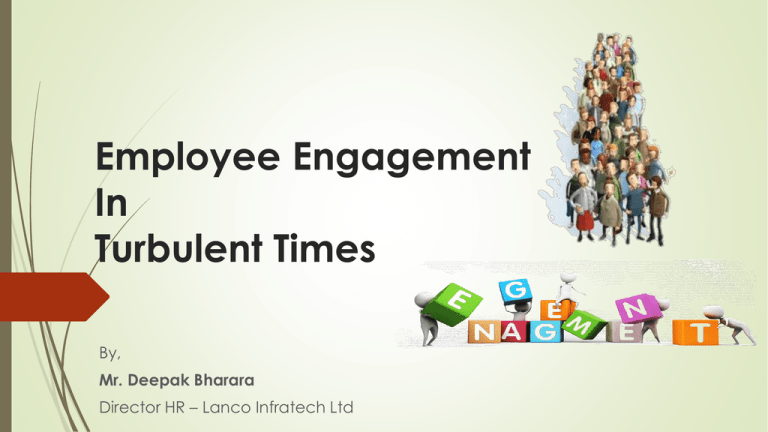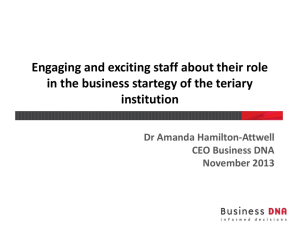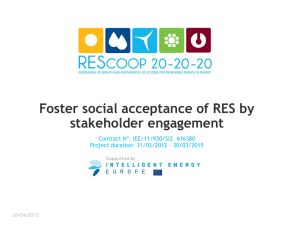Employee Engagement In Turbulent Times
advertisement

Employee Engagement In Turbulent Times By, Mr. Deepak Bharara Director HR – Lanco Infratech Ltd Should the context of TIME be our Focus? Or How We proactively & productively engage employees? Land Acquisition Local Agitations Cost of Power - State control on selling of Power Project Finance Challenges of Power Sector Poor Health of Discoms/ SEBs Availability of EPC Contractor at Remote Locations FUEL LINKAGES (Coal/Gas) Project Management Capability Regulatory Challenges Succession planningcreation of leadership pipeline Ensuring system effectiveness Challenges of LANCO Value Based Leadership Fuel Availability & Logistics of Fuel Evacuation Effective Project Management - Timely Completion Capability Development to meet dynamic business scenario Impact of Economic Slowdown on Employees Low Engagement Low Productivity • Insecurity – Downsizing/Salary cuts/ withdrawal of benefits • Unable to anticipate the future • Heavy workload with limited resources and/or salary • Direct correlation between the level of employee engagement and the productivity/success of the business organization. • Difficult economic phases create pressure to optimize resources and results What makes good companies great is their ability to attract, retain, and engage the right employees – in difficult times, even more so. Factors that Influence Environment/ Time [Non Controllable] Leadership drives Engagement • The Cascading effect : Engagement starts at top, and without engaged senior leadership, companies are not be able to engage the hearts and minds of their employees. • Turbulent times call for bold leadership in all sectors and in spheres • It is essential to learn leadership fundamentals, in order to maintain high morale. • Make sure that all individuals are in the correct positions and have strong leadership skills in place in order to face challenges. • Engage with leaders who have successfully thrive during difficult economic times. • Develop a strong leadership pipeline in an organization. • Engaged managers are more likely to build engaged teams Distinctive Leadership practices influencing Engagement Connecting with employees Effectively communicate the organisation’s goals and objectives Consistently demonstrate the organisation’s values in all behaviours and actions Appropriately balance employee interests with those of the organisation Fill employees with excitement for the future of the organisation Performance focussed Effectively communicate the organisation’s goals and objectives Empower managers and employees and instil a culture of accountability Set aggressive goals at all levels of the organisation Future and development oriented Communicate the importance of spending time on feedback and provide performance coaching Fill employees with excitement about the future of the organisation Effectively communicate the skills/capabilities employees must develop for future success Invest in long-term growth opportunities, even during difficult times *Source: Aon Hewitt Re-Engagement in Tough Times Stay Centred to your Core Values Explicitly Support your Employee Solicit Employee Feedback Communicate Up Front with Employees Commit to Your Employee’s Employment Enhance Career Growth , Learning & Development Increase Recognition Demonstrate a strong commitment to employee well being Innovative and sustainable business practices Engagement – Responsibility at different Levels Employee Engagement is the responsibility of the entire work force and at all levels in the organization Individual Level Managerial level Executive level Responsibility at Individual Level Engagement is fundamentally an individualized equation – reflects each person’s unique relationship with work Individuals must: Own their engagement – they are ultimately responsible for their personal and professional success Be clear on their core values and goals – if they do not know what is important to them, they will not find it in their current job, or potentially in any other Take action –need to take Initiative To Build their skill sets To Articulate their interests To Satisfy their core values To Identify ways to apply their talents to achieve organization’s goals To Have conversations about reshaping their jobs To Clarify their work priorities To Get the support they need from Managers Responsibility at Managerial Level Managers matter – they work in the core where employee engagement happens – or does not – their sphere of control is limited – they can’t change direction if the organization is stumbling, and they can’t actually make employees Engaged Managers must, however: Take control of their own engagement – remember they are individual employees first, managers second Facilitate team members’ unique engagement equations through coaching – understand each member’s unique interests, talents and aspirations – align individuals’ passions and proficiencies with clearly articulated organizational priorities and projects – keep the dialogue going by providing feedback, course corrections and development opportunities to ensure high performance Build Relationships – drop the veil of your positions and become known to employees, sharing personal motivation for work, challenges, appropriate weaknesses, the reasons they came to the organization – and why they stay Appreciate team dynamics – need to deal quickly with potential problems and also capitalize on the enthusiasm and work ethic of Engaged team members to ignite the team as a whole Responsibility at Executive Level Executive Behaviour sometimes matters more than manager actions – after all, they have the farthest reach To fulfill their ‘individual’ and ‘manager’ responsibilities, Executives need to – Commit or quit – regularly reflect on why they joined and why they stay Pay attention to engagement of their direct reports – if they expect leaders at all levels to coach their people to higher levels of engagement but do not do it themselves, they undermine their message Executives also need to – Talk about engagement with passion – weave engagement into the daily workplace conversations Build a culture that fuels engagement – promote practices that propel High Performance and weed out practices that undermine performance Inspire commit & trust – communicate ‘what’ and ‘why’ of decisions, demonstrate visible commitment to organization success in their ‘Actions’ Set a clear direction – Clearly Articulated Compelling Vision Strategy LANCO Infratech Limited From 2006 - 2013 A Saga of High Growth to Slow Down LANCO’s Rapid Growth (2006-10) Levels Individual Manager Executive Engagement Initiatives 1. Work on cross functional roles 2. Taking new projects/ responsibilities 3. Aligning oneself with the big picture 1. 2. 3. 4. 5. Rewards & Recognition Transparent Performance Management Aligning individual KRA’s with Business Goals Team Parties Celebration of special Occasions 1. 2. 3. 4. 5. Building Leadership Framework Working on Succession Management Building the Lanco Culture Organization Structuring Technological Up gradation LANCO’s Slow Down (2010-13) Levels Engagement Initiatives Individual 1. 2. 3. 4. 5. Manager 1. Carving out new roles for team members within function/other function /other group company 2. Town Halls 3. Coffee Meetings 4. Celebrating small successes 5. Developing Team Members 6. Cost Control Measures Executive 1. 2. 3. 4. 5. Developing knowledge & skills Level Cross Functional Projects Participating in open sessions with seniors & HR Revisiting processes Cost Control initiatives Open & Transparent Communication Building organization Culture Focusing on Values of the organization Re aligning Organization Structure Cost Efficient Culture Mistakes to be Avoided during Employee Engagement Initiatives 1. Consistently asking for feedback and not taking action once received 2. Glossing over the hard stuff, and without getting to the root of real issues. If an organisation focuses only on fun without addressing the core issues, fun activities are wasted 3. Not outlining clear ownership between HR, and business units, and within business units, or ensuring the action owners have the authority required to make critical changes 4. Connecting engagement to performance measures without monitoring the negative impacts it can create, e.g. Gaming. Although what gets measured, gets done, measuring the wrong things can create adverse effects 5. Trying to change the engagement score, rather than fix the issues that make up the score. Programmes focused on changing engagement must be connected to business core values, and tied to the operating principles and behaviour of the organisation 6. Misjudging the performance anatomy, culture or values of an organisation. How a company performs on engagement is in many ways tied to the performance anatomy of their organisation, its culture, personality and leadership POWER OF EMPLOYEES ENGAGEMENT - DIAL/HIAL Or -Turnaround a REAL TIME SUCESSS STORIES on Active Employees Engagement Top Trends Lead to Focus on Employee EngagementUnprecedented Changes are happening in global market place Employee-employer relationship evolving/changing to partnerships Increased demand for work life balance HR’s greater role in promoting the link between employee performance and its impact on business goals Increasing focus on selective retention for keeping mission critical talent Work intensification as employers increase productivity with fewer employees and resources Acquiring and keeping key talent re-emerging as top issues of concern Decline in traditional communication methods and increase in cyber communication Needs, wants and behaviors of the talent pool driving changes in attraction, selection and retention practices








